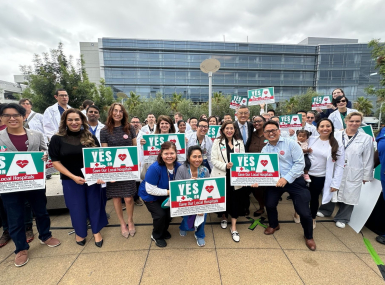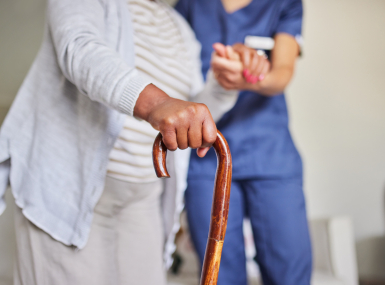Medication-Assisted Treatment (“MAT”) for Opioid Use Disorder: A NACo Opioid Solutions Strategy Brief

Upcoming Events
Related News
“Medication-assisted treatment works. The evidence on this is voluminous and ever growing . . . failing to offer MAT is like trying to treat an infection without antibiotics.”
– Alex Azar II, Secretary of the U.S. Department of Health and Human Services, 2018-20211
What is medication-assisted treatment (“MAT”) for opioid use disorder?
The Food and Drug Administration (FDA) has approved three medications that safely and effectively treat opioid use disorder (OUD) to improve the health and wellbeing of people living with OUD. MAT is defined by on-going, long-term treatment with one of these three medications.
How does MAT with medications for opioid use disorder (MOUD) work?
OUD is characterized by continued opioid use — or feeling incapable of controlling one’s opioid use — despite negative consequences such as injury, illness, fractured relationships, arrest or incarceration.
Opioid cravings can pose challenges to people who want to stop or reduce their opioid use. When they do stop, people with OUD may experience withdrawal symptoms, including vomiting, diarrhea, fever, muscle aches, tremors, insomnia, anxiety or depression. Fear and avoidance are normal responses to withdrawal experiences and can be an obstacle for people who want to use less or stop using entirely. The FDA has approved three medications for treating OUD: methadone, buprenorphine and naltrexone. Methadone and buprenorphine work by reducing cravings and preventing withdrawal. Naltrexone works by blocking the effects of opioids in the body.
Methadone
- Methadone reduces cravings and controls withdrawal symptoms because it is an opioid.
- Methadone must be taken daily, though some people need to take methadone twice daily.
- When used to treat OUD, methadone can only be dispensed by federally registered Opioid Treatment Programs (OTPs).
Buprenorphine
- Buprenorphine, sometimes referred to as “bupe,” reduces cravings and controls withdrawal symptoms because it is a partial opioid.
- Buprenorphine can be taken at home daily OR administered by a clinician as a long-acting injection.
- Buprenorphine can be prescribed by any qualified clinician.
- As of December 9, 2022, any practitioner with current DEA registration that includes the authority to prescribe Schedule III medications may prescribe buprenorphine as allowable by state law. The DATA waiver (X waiver) requirement has been removed.2-3
Naltrexone
- Naltrexone is an opioid blocker. It prevents opioids from affecting the body.
- Naltrexone can be taken at home daily OR administered by a clinician as a long-acting injection.
- Naltrexone can be prescribed by any clinician licensed to prescribe medication.4
How does an opioid treat opioid use disorder?
Methadone and buprenorphine are opioid medications that reduce cravings and withdrawal. Unlike many illicit opioids, these medications have a stabilizing effect which helps to end the constant cycle of craving and withdrawal.
All three medications can be used alone or in conjunction with cognitive or behavioral therapy, intensive outpatient treatment, inpatient (residential) treatment, psychiatric care or other social and healthcare services — as appropriate for each individual person according their needs and circumstances.
Treating OUD with opioid medications (methadone and buprenorphine, specifically) has long been considered the gold-standard of care.5-6 However, no single medication works well for all. Equal access to all three supports finding the treatment that works best and patient preference remains one of the most important factors. All things being equal, the best medication choice may be the one a person is interested in trying or the one they will continue to take.
MOUD can help people living with OUD prevent overdose, achieve abstinence and "feel normal" again. Hear Chase's story.
What evidence supports MAT as a public health strategy?
While all three manage OUD symptoms, only methadone and buprenorphine have been proven to prevent opioid overdose.7-8 In contrast, evidence is growing that naltrexone increases the risk of overdose among those who take it to treat OUD.9-10
Methadone and buprenorphine
Methadone and buprenorphine have been used to treat OUD for decades. Methadone and buprenorphine work; the evidence is vast, strong and consistent.5-6 People with OUD taking prescribed methadone or buprenorphine are 50% less likely to die of overdose compared to no treatment and compared to those taking naltrexone.7-8 Because methadone and buprenorphine are opioids, they reduce cravings and withdrawal symptoms while maintaining opioid tolerance. Maintaining tolerance reduces the risk of death in the event of return to illicit use.
Naltrexone
Naltrexone has been used for decades to treat alcohol use disorder; it is the newest FDA-approved medication for treating OUD. Studies show naltrexone to be effective at treating OUD.9-10 Individuals prescribed naltrexone are more likely to drop out of treatment in the first 30 days compared to those taking buprenorphine.11-12 In 2019, the FDA released a warning about increased risk of overdose after cessation of naltrexone treatment.13 This risk may exist while someone remains in treatment.14 Because naltrexone is not an opioid, people taking it lose their opioid tolerance, which increases risk of harm in the event of return to illicit use.
Are there risks to my community or institution if we don’t support access to MAT?
Yes. First, treatment with MOUD — especially methadone and buprenorphine — is in high demand across the United States; yet demand far exceed availability. People seeking treatment with MOUD often experience long travel-times, insurance barriers, prohibitive out-of-pocket expenses, provider stigma and long waitlists;15-18 some of these problems worsened during COVID-19.19 Many people die waiting to receive treatment.20
Second, failed attempts to access buprenorphine through a healthcare provider is strongly associated with illegally obtained prescription medications to self-treat OUD.20-21 Insufficient access to MOUD can lead to diversion and misuse of prescription drugs.
Third, the Americans with Disabilities Act (ADA) offers protections to people who are receiving treatment for a substance use disorder. Discrimination against persons receiving treatment for OUD is considered a violation of the ADA and could be grounds for legal action. Numerous lawsuits have been successfully brought against criminal justice institutions, drug courts, employers, residential programs and healthcare providers for refusal to accommodate persons receiving MOUD, sometimes resulting in settlements in the hundreds of thousands.22-23
Are there best practices for supporting or implementing MAT?
- Support equal access to all three FDA-approved medications (“We need all 3!”) so healthcare providers can reliably access the right tools for the right patients.
- Support access to all three FDA-approved MOUD for people who are incarcerated or under community supervision.24
- Get creative. Support access in rural and underserved areas via teleheath25-26 and mobile clinics.27
- Remove cost barriers. Leverage resources to fund MOUD, cover the out-of-pocket/retail cost for people with limited insurance,17,28 support continuing MOUD for parenting patients who may lose Medicaid or other coverage after giving birth.29
- Encourage “medication first” policies that provide MOUD as soon as possible and without conditions (e.g., tapering schedules, mandatory acceptance of other services).30-33
- Fight stigma. Voice strong support for MOUD as effective treatment for OUD. Stigma and misinformation pose significant barriers to residents getting the care they need.16
A Note On Language
You may see Medication Assisted Treatment (MAT) referred to as Medications for Opioid Use Disorder (MOUD) in medical journals and other settings. MAT and MOUD are the same thing. “MAT” was first used to convey that certain medications could “assist” other forms of therapy in promoting recovery. It is true that many people living with OUD benefit from counseling and other therapies while also being treated with medications. However, favor has shifted to using “MOUD” as research shows that these medications provide effective, tangible benefits to people living with OUD even without other forms of counseling. Medications do not only “assist” treatment; medications are a core component of treatment.
Author,
Jennifer J. Carroll, PhD, MPH
Additional Resources
- Centers for Disease Control and Prevention, “Evidence-Based Strategies for Preventing Opioid Overdose: What’s Working in the United States”
- Brandeis Opioid Resource Connector, “What is Treatment for Opioid Use Disorder?”
- Partnership to End Addiction, “Learn How Medication Can Help Treat Opioid Addiction”
- American Society of Addiction Medicine, “Opioid Addiction Treatment”
- Shatterproof, “Medications for Addiction Treatment”
- Harvard Medical School, Blavatnik Institute for Health Care Policy, “The Opioid Epidemic: Evidence Based Strategies for Abatement of Harms”
The ORN is a technical assistance collaboration between the American Academy of Addiction Psychiatry and Columbia University. Funded by SAMHSA, the ORN has local consultants in all 50 states and 9 U.S. territories to provide communities with free technical assistance and education on the prevention and treatment of OUD.
Opioid and Stimulant Implementation Support Training and Technical Assistance (OASIS-TTA)
OASIS-TTA, hosted by the University of California, Los Angeles, is on online repository of resources and toolkits for establishing MOUD services in a variety of health and social service settings. OASIS-TTA accepts direct requests for technical assistance.
Rural Communities Opioid Response Program – Technical Assistance (RCORP-TA)
RCORP-TA is a multi-year initiative by the Health Resources and Services Administration (HRSA) that offers online technical assistance resources.
Rural Health Information Hub (RHIhub)
RHIhub hosts a comprehensive series of online training modules to support community leaders and healthcare practitioners in better understanding proven and available strategies for improving MOUD access.
- Azar II AM. Plenary Address to National Governors Association. HHS.gov. Published February 24, 2018. Accessed June 8, 2022. https://public3.pagefreezer.com/browse/HHS.gov/31-12-2020T08:51/https:/www.hhs.gov/about/leadership/secretary/speeches/2018-speeches/plenary-addres-to-national-governors-association.html
- U.S. Substance Abuse and Mental Health Services Administration. Certification of Opioid Treatment Programs (OTPs). U.S. Substance Abuse and Mental Health Services Administration. Published 2022. Accessed June 8, 2022. https://www.samhsa.gov/medication-assisted-treatment/become-accredited-opioid-treatment-program
- U.S. Substance Abuse and Mental Health Services Administration. Become a Buprenorphine Waivered Practitioner. SAMHSA. Published 2022. Accessed June 8, 2022. https://www.samhsa.gov/medication-assisted-treatment/become-buprenorphine-waivered-practitioner
- U.S. Substance Abuse and Mental Health Services Administration. Naltrexone. U.S. Substance Abuse and Mental Health Services Administration. Published 2022. Accessed June 8, 2022. https://www.samhsa.gov/medication-assisted-treatment/medications-counseling-related-conditions/naltrexone
- Mattick RP, Breen C, Kimber J, Davoli M. Methadone Maintenance Therapy Versus No Opioid Replacement Therapy for Opioid Dependence. In: Cochrane Database of Systematic Reviews. John Wiley & Sons, Ltd; 2009. Accessed January 30, 2014. http://onlinelibrary.wiley.com/doi/10.1002/14651858.CD002209.pub2/abstract
- Mattick RP, Breen C, Kimber J, Davoli M. Buprenorphine maintenance versus placebo or methadone maintenance for opioid dependence. Cochrane Database Syst Rev. 2014;(2):CD002207. doi:10.1002/14651858.CD002207.pub4
- National Institutes of Health. Methadone and buprenorphine reduce risk of death after opioid overdose. National Institutes of Health (NIH). Published June 19, 2018. Accessed June 8, 2022. https://www.nih.gov/news-events/news-releases/methadone-buprenorphine-reduce-risk-death-after-opioid-overdose
- Wakeman SE, Larochelle MR, Ameli O, et al. Comparative Effectiveness of Different Treatment Pathways for Opioid Use Disorder. JAMA Network Open. 2020;3(2):e1920622.
- Ajazi EM, Dasgupta N, Marshall SW, et al. Revisiting the X: BOT Naltrexone Clinical Trial Using a Comprehensive Survival Analysis. Journal of Addiction Medicine. Published online December 3, 2021. doi:10.1097/ADM.0000000000000931
- Cheney, T. Vivitrol and Overdose Risk. Maine Suboxone - Enso Recovery. Published Online February 2022. Accessed June 8, 2022. http://mainesuboxone.com/index.php/2022/02/13/vivitrol-and-overdose-risk/
- Alkermes Inc. VIVITROL (naltrexone for extended-release injectable suspension) [package insert]. Published online September 2019. Accessed June 8, 2022. https://www.accessdata.fda.gov/drugsatfda_docs/label/2019/021897s045lbl.pdf
- Krupitsky E, Nunes EV, Ling W, Illeperuma A, Gastfriend DR, Silverman BL. Injectable extended-release naltrexone for opioid dependence: a double-blind, placebo-controlled, multicentre randomised trial. Lancet. 2011;377(9776):1506-1513. doi:10.1016/S0140-6736(11)60358-9
- Comer SD, Sullivan MA, Yu E, et al. Injectable, sustained-release naltrexone for the treatment of opioid dependence: a randomized, placebo-controlled trial. Arch Gen Psychiatry. 2006;63(2):210-218. doi:10.1001/archpsyc.63.2.210
- Morgan JR, Schackman BR, Leff JA, Linas BP, Walley AY. Injectable naltrexone, oral naltrexone, and buprenorphine utilization and discontinuation among individuals treated for opioid use disorder in a United States commercially insured population. J Subst Abuse Treat. 2018;85:90-96. doi:10.1016/j.jsat.2017.07.001
- Gryczynski J, Schwartz R, O’Grady K, Jaffe J. Treatment entry among individuals on a waiting list for methadone maintenance. Am J Drug Alcohol Abuse. 2009;35(5):290-294. doi:10.1080/00952990902968577
- Cernasev A, Hohmeier KC, Frederick K, Jasmin H, Gatwood J. A systematic literature review of patient perspectives of barriers and facilitators to access, adherence, stigma, and persistence to treatment for substance use disorder. Explor Res Clin Soc Pharm. 2021;2:100029. doi:10.1016/ jrsop.2021.100029
- Dunphy C, Peterson C, Zhang K, Jones CM. Do out-of-pocket costs influence retention and adherence to medications for opioid use disorder? Drug Alcohol Depend. 2021;225:108784. doi:10.1016/j.drugalcdep.2021.108784
- Oros SM, Christon LM, Barth KS, Berini CR, Padgett BL, Diaz VA. Facilitators and barriers to utilization of medications for opioid use disorder in primary care in South Carolina. Int J Psychiatry Med. 2021;56(1):14-39. doi:10.1177/0091217420946240
- Joudrey PJ, Adams ZM, Bach P, et al. Methadone Access for Opioid Use Disorder During the COVID-19 Pandemic Within the United States and Canada. JAMA Network Open. 2021;4(7):e2118223-e2118223. doi:10.1001/jamanetworkopen.2021.18223
- Peles E, Schreiber S, Adelson M. Opiate-dependent patients on a waiting list for methadone maintenance treatment are at high risk for mortality until treatment entry. J Addict Med. 2013;7(3):177-182. doi:10.1097/ADM.0b013e318287cfc9
- Carroll JJ, Rich JD, Green TC. The More Things Change: Buprenorphine/naloxone Diversion Continues While Treatment Remains Inaccessible. Journal of Addiction Medicine. 2018;12(6):459-465. doi:10.1097/ADM.0000000000000436
- Legal Action Center. Cases Involving Discrimination Based on Treatment with Medication for Opioid Use Disorder (MOUD). Published online June 6, 2022. Accessed June 8, 2022. https://www.lac.org/assets/files/Cases-involving-denial-of-access-to-MOUD.pdf
- U.S. Department of Justice. Justice Department Files Suit Against Pennsylvania Court System for Discriminating Against People with Opioid Use Disorder. The United States Department of Justice. Published February 24, 2022. Accessed June 8, 2022. https://www.justice.gov/opa/pr/justice-department-files-suit-against-pennsylvania-court-system-discriminating-against-people
- McClellan C, Moriya A, Simon K. Users of retail medications for opioid use disorders faced high out-of-pocket prescription spending in 2011-2017. J Subst Abuse Treat. 2022;132:108645. doi:10.1016/j.jsat.2021.10864528
- Gifford K, Walls J, Ranji U, Apr 27 IGP, 2017. Medicaid Coverage of Pregnancy and Perinatal Benefits: Results from a State Survey. KFF. Published April 27, 2017. Accessed June 8, 2022. https://www.kff.org/womens-health-policy/report/medicaid-coverage-of-pregnancy-and-perinatal-benefits-results-from-a-state-survey/29
- Carroll JJ, Green TC, Noonan RK. Evidence-Based Strategies for Prevention Opioid Overdose: What’s Working in the United States. Published online 2018. Accessed October 10, 2018. http://www.cdc.gov/drugoverdose/pdf/pubs/2018-evidence-based-strategies.pdf24
- Clark SA, Davis C, Wightman RS, et al. Using telehealth to improve buprenorphine access during and after COVID-19: A rapid response initiative in Rhode Island. J Subst Abuse Treat. 2021;124:108283. doi:10.1016/j.jsat.2021.10828325
- El-Sabawi T, Baney M, Canzater SL, Weizman S. The New Mobile Methadone Rules And What They Mean For Treatment Access | Health Affairs Forefront. Health Affairs. Published August 4, 2021. Accessed June 8, 2022. https://www.healthaffairs.org/do/10.1377/forefront.20210727.942168/full/26
- Kawasaki S, Hwang G, Buckner K, et al. Collaborative health systems ECHO: The use of tele-education platform to facilitate communication and collaboration with recipients of state targeted response funds in Pennsylvania. Subst Abus. 2022;43(1):892-900. doi:10.1080/08897077. 2021.200751927
- Winograd RP, Presnall N, Stringfellow E, et al. The case for a medication first approach to the treatment of opioid use disorder. American Journal of Drug & Alcohol Abuse. 2019;45(4):333-340.
- Brooklyn JR, Sigmon SC. Vermont Hub-and-Spoke Model of Care for Opioid Use Disorder: Development, Implementation, and Impact. J Addict Med. 2017;11(4):286-292. doi:10.1097/ ADM.0000000000000310
- Winograd RP, Wood CA, Stringfellow EJ, et al. Implementation and evaluation of Missouri’s Medication First treatment approach for opioid use disorder in publicly-funded substance use treatment programs. J Subst Abuse Treat. 2020;108:55-64. doi:10.1016/j.jsat.2019.06.015
- Prevention Point Philadelphia. STEP. Prevention Point. Published 2020. Accessed June 8, 2022. https://ppponline.org/node/125/step
Featured Initiative
Opioid Solutions Center
NACo's Opioid Solutions Center empowers local leaders to invest resources in effective treatment, recovery, prevention and harm reduction practices that save lives and address the underlying causes of substance use disorder.






